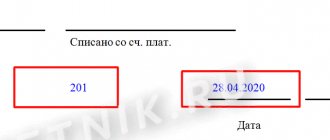Account 04 “Intangible assets” is intended to collect information about the company’s property intended for long-term profit-making and not having a tangible form (patents, programs, trademarks, etc.).
Intangible assets (intangible assets) accounted for on account 04 include the company’s own non-current property that meets the following requirements:
- has properties characteristic of fixed assets, namely:
intended for long-term use to generate income;it is possible to select an object, determine its initial and market value;
- has no physical form;
- the company has registered ownership, confirmed by relevant documents.
Thus, intangible assets can be:
- musical, literary, artistic works;
- computer software products;
- know-how, utility models, inventions:
- Database;
- trademarks and service marks;
- other objects of intellectual property - the list established by PBU 14/2007 is open.
Attention! Intangible assets also include business reputation - the positive difference between the purchase price and the book price of the company.
Account information 04 is taken into account as the sum of all inventory items on the balance sheet (initial or actual cost). The actual cost includes all costs of purchase, delivery, customs duties, intermediary fees, consulting, and does not include VAT.
Like other property accounts, it is active, that is, according to Dt they reflect the receipt (increase) of value, according to Kt - a decrease (write-off, disposal).
The asset is accepted for accounting on the account. 04 not immediately, but after a while. 08 “Investments in non-current assets”, where the initial cost of the property is formed. After the object is completely ready to perform its functions and meets all the requirements established by the Accounting Regulations for intangible assets, the asset is debited to the account. 04 from account 08.
Attention! According to the account 04 is not taken into account:
- unregistered objects of intangible assets, patents and utility models, evidence for which has not been published by the body that protects intellectual property;
- scientific work, the results of which turned out to be negative or unfinished, executed in an inappropriate manner;
- financial investments are objects initially acquired for profit through the transfer of rights of use to third parties (and not for use in one’s own production).
Subaccounts used
The instructions for the Chart of Accounts do not establish which specific sub-accounts the organization should use, however, it is stated that analytics should be carried out in the context of various types of property, for example:
04/1 - patents,
04/2 - inventions,
04/3 - databases,
04/5 – other intangible assets.
Depending on the specifics of its financial and economic activities, the organization annually creates a working chart of accounts, where it approves the subaccounts necessary for the work. As a rule, small business organizations do not own a large number of intangible assets and do not need wide disclosure of account 04, however, this may be relevant for scientific and research organizations, universities, design and engineering companies.
Subaccounts of account 04
Let us consider in detail the subaccounts that can be opened to the account for intangible assets in accounting:
- Subaccount 04-1 “Exclusive rights” serves to summarize information about the rights of the patent holder, author or trademark owner.
- Subaccount 04-02 “Organizational expenses” records expenses that are associated with the creation of a legal entity and are part of the founders’ contribution to the authorized capital of the enterprise.
- Subaccount 04-03 “Business reputation” reflects the positive business reputation that arises when purchasing an enterprise (as property) if the acquisition price exceeds the book value of all the company’s assets, and when purchasing at an auction or competition - the estimated value.
- Subaccount 04-04 “Expenditures on research, development and technological work” is necessary to summarize information about the enterprise’s costs for these types of work.
Basic Operations
Admission
An object can be accepted for accounting as a result of acquisition for a fee, received free of charge, created on its own, or discovered as a result of an inventory.
Acceptance of an acquired (created) intangible asset for accounting occurs through account 08, on which the actual cost of the property is formed.
Acceptance of an object for accounting is documented by the following transactions:
Dt 08 Kt 60 - purchase costs;
Dt 08 Kt 10 (70, 69) – expenses for materials (salaries, insurance premiums) related to the creation of an intangible asset;
Dt 19 Kt 60 – VAT allocated;
Dt 04 Kt 08 – the actual cost has been generated.
Sale
When selling intangible assets, the accountant needs to calculate the residual value, reducing the accounting price (account 04) by the amount of depreciation (account 05):
Dt 62 Kt 91 – sale reflected;
Dt 91 Kt 68 – VAT allocated;
Dt 05 Kt 04 – depreciation written off;
Dt 91 Kt 04 – residual value written off.
Attention! It is worth remembering that property initially acquired for resale, including those that do not have a tangible form, is not taken into account as part of non-current assets.
Stage 1 – calculation of PNA and PNA according to PR
We look at the Tax accounting register by type of accounting PR in turnover on accounts 90 and 91 not in correspondence with the account.
99.01. It is obvious from the entries that permanent differences are included in income tax calculations only after they are reflected in the income or expenses of the organization. Any balances of PR on the balance sheet accounts of assets or liabilities DO NOT AFFECT the tax calculation!
Postings are generated:
Dt 99.02.3 Kt 68.04.2 for the amount (TurnoverDt * Profit Tax Rate) – PNO
Dt 68.04.2 Kt 99.02.3 for the amount (TurnoverKt * Profit Tax Rate) – PNA
General rule:
If profit (income minus expenses) according to accounting data is greater than according to NU data, then a permanent tax asset (PTA) is formed, otherwise a permanent tax liability (PTA) arises.Simply put: positive amount of PR in income * 20% = PNA; positive PR in expenses * 20% = PNO
Example:
Dt 26 PR for 100,000 rubles. – costs are reflected. At the end of the month, they will form a debit turnover on the account. 90.
Dt 99.02.3 Kt 68.04.2 for 20,000 rubles. – reflection of PNO
Stage 2 – calculation of OTA for current loss. period (according to NU data, only if there is a loss)
We look at balances 99 by accounting type and balances 09 “LossTekPer” by accounting.
Loss of the current period 09 = AmountFinalBalanceDt_account99.01NU * ProfitTax Rate - AmountFinalBalanceDt_account09BU for the subaccount Loss of the CurrentPeriod
Postings are generated:
Dt 68.04.2 Kt 09 – if the amount is negative
Dt 09 Kt 68.04.2 – if the amount is positive
It is necessary for the organization to have income tax rates filled in (through the accounting policy); without them, the calculation does not work correctly.
Stage 3 – calculation of ONA and ONO for BP in the accounts of types of assets and liabilities
Please note: unlike PNA/PNO, ONA and ONO are formed at the moment the temporary difference ARISES in the accounts of assets and liabilities, and not at the moment it is recognized as income or expenses.
Thus, the emergence of VR in the evaluation of materials on the account. 10 will lead to the formation of IT, even if these materials were in the warehouse for the entire month and were not written off anywhere!
The procedure for calculating “as it should be” , according to the 1C comments in the standard UPP code:
- The balance of taxable and deductible differences by type of asset as a whole is determined.
- Based on the balance of the differences, the balance of deferred tax assets and liabilities is calculated, which should be reflected in accounts 09 and 77 at the end of the month.
- The amount of deferred tax assets and liabilities is determined, which is reflected in accounts 09 and 77 at the end of the month.
- Accounts 09 and 77 are adjusted to the amount of the differences between what is reflected on the account and what should be based on the calculation results.
The calculation procedure “as is” , directly from the standard SCP code:
- Balances and turnover are calculated by type of accounting BP for types of assets and liabilities. Accounting accounts related to predefined types of assets and liabilities are specified in the code (see table below for types of assets and liabilities).
- The result of the calculation in the form Beginning Balance / TurnoverDt / TurnoverKt / BalanceCon (for all tax accounts of this type of asset) is processed separately for each set of subconto values according to the following algorithm:
- If Beginning Balance > 0 :
| (BalanceEn – BalanceStart) > 0 : | AmountKt77 = TurnoverDt-TurnoverKt |
| (BalanceCon < 0) : | AmountDt09 = — BalanceEnd AmountDt77 = BalanceStart |
| Otherwise | AmountDt77 = - (TurnoverDt-TurnoverKt) |
- If Beginning Balance <= 0 :
| (BalanceEn – BalanceStart) < 0 : | SumDt09 = - BalanceEnd + BalanceStart; |
| (BalanceCon > 0) : | SumKt77 = BalanceCon; SumKt09 = — Beginning Balance; |
| Otherwise | SumKt09 = TurnoverDt-TurnoverKt. |
For fixed assets and intangible assets, depreciation accounts are included in the calculation, i.e.
The calculation is based on the residual value. Postings to accounts 09, 77 are generated in correspondence with account 68.04.2.
When recording, entries are “rolled up” by type of asset and liability in each account.
The transaction amount is multiplied by the income tax rate.
Accounting balances on accounts 09, 77 are not taken into account.
What are intangible assets?
Intangible assets are non-current assets; unlike fixed assets, they do not have a physical form and are the result of intellectual activity.
In accounting, the concept of intangible assets is discussed in detail in PBU 14/2007; this provision regulates all activities related to intangible assets.
Intangible assets include: (click to expand)
Exclusive right to an invention, industrial design, utility model. Exclusive copyright to computer programs, databases. Property right to topologies of integrated circuits. Exclusive right to a trademark, company name, commercial designations. Exclusive right to selection achievements. Business reputation of the organization (Civil Code). Know-how (Tax Code).
Typical postings for account 04
By debit of the account
| Contents of a business transaction | Debit | Credit |
| Intangible exploration assets are transferred to intangible assets | 04 | 08 |
| NMA put into operation | 04 | 08-5 |
| R&D costs taken into account | 04 | 08-8 |
| The initial cost of intangible assets, which was taken into account incorrectly, has been adjusted. | 04 | 76-2 |
| Intangible assets received from the head office of the organization are capitalized (posting in the branch accounting) | 04 | 79-1 |
| Intangible assets received from a branch allocated to a separate balance sheet have been capitalized (posting in the accounting of the organization’s head office) | 04 | 79-1 |
| Intangible assets received for trust management are capitalized (on a separate trust management balance sheet) | 04 | 79-3 |
| The intangible asset transferred into trust management has been capitalized (posting in the accounting of the management founder) | 04 | 79-3 |
| Intangible assets received as a contribution under a joint activity agreement were capitalized (on a separate balance sheet of the joint activity) | 04 | 80 |
By account credit
| Contents of a business transaction | Debit | Credit |
| Depreciation on intangible assets disposed of as a result of sale, gratuitous transfer or liquidation is written off as a reduction in the original cost | 05 | 04 |
| R&D costs written off | 20 | 04 |
| Calculation of depreciation for intangible assets used in the main production (without using account 05) | 20 | 04 |
| Calculation of depreciation for intangible assets used in auxiliary production (without using account 05) | 23 | 04 |
| Calculation of depreciation for intangible assets for general production purposes (without using account 05) | 25 | 04 |
| Calculation of depreciation on intangible assets for general business purposes (without using account 05) | 26 | 04 |
| Calculation of depreciation on intangible assets in service production (without using account 05) | 29 | 04 |
| Calculation of depreciation on intangible assets used to support the sales process (without using account 05) | 44 | 04 |
| Calculation of depreciation for intangible assets of a trading organization (without using account 05) | 44 | 04 |
| The residual value of intangible assets is written off from insurance compensation. | 76-1 | 04 |
| Intangible assets were transferred to a branch allocated to a separate balance sheet (posting in the accounting of the head office) | 79-1 | 04 |
| Intangible assets were transferred to the head office, allocated to a separate balance sheet (posting in the branch accounting) | 79-1 | 04 |
| Intangible asset transferred to trust management (posting in the accounting of the management founder) | 79-3 | 04 |
| Intangible assets transferred to trust management are returned (on a separate balance sheet of trust management) | 79-3 | 04 |
| Transferred to the participant of a simple partnership of intangible assets upon termination of the agreement on joint activity (on a separate balance sheet of the joint activity) | 80 | 04 |
| The residual value of intangible assets disposed of as a result of sale or write-off is taken into account as part of other expenses | 91-2 | 04 |
Typical types of assets and liabilities with accounting accounts and analytics (from the SPP code)
| Types of assets and liabilities | Accounts | Subconto | A comment |
| Accounts payable | — | — | // automatic calculation of SHE and IT is not performed!!! |
| Profitable investments in material assets | — | — | // automatic calculation of SHE and IT is not performed!!! |
| Current period loss | — | — | // Calculation using a special algorithm |
| Fixed assets | 01, 02.01 | Fixed assets | //Fixed assets |
| Fixed assets | 10.MC | Nomenclature | //Assets recognized as inventories in accounting records and fixed assets in accounting records |
| Fixed assets | 02.02, 03 | Fixed assets | //Profitable Investments in_MC |
| Intangible assets | 04, 05 | Intangible assets | |
| Equipment | 07 | Warehouses, Nomenclature | |
| Fixed assets | 08.01 | Construction objects | |
| Fixed assets | 08.02 | Construction objects | |
| Fixed assets | 08.03 | Construction objects | |
| Fixed assets | 08.04 | Warehouses, Nomenclature | |
| Fixed assets | 08.05 | Intangible assets | |
| Fixed assets | 08.08 | R&D expenses | |
| Fixed assets | 08.11, 08.12 | — | |
| Materials | 10.01, 10.02, 10.03, 10.04, 10.05, 10.06, 10.08, 10.09, 10.10 | Warehouses, Nomenclature | |
| Materials | 10.07 | Counterparties, Nomenclature | // Materials in processing |
| Materials | 10.11 | Nomenclature | // Materials in use |
| Unfinished production | 20.01.1, 23.01, 28.01, 29.01 | Divisions, Nomenclature groups | |
| Indirect production costs | 20.01.2, 23.02, 25, 26 | Expenditures | |
| Unfinished production | 20.02 | Nomenclature | |
| Finished products | 43 | Warehouses, Nomenclature | |
| Semi-finished products | 21 | Warehouses, Nomenclature | |
| Future expenses | 97 | Future expenses | |
| Goods | 41 | Warehouses, Nomenclature | |
| Goods shipped | 45 | Nomenclature | |
| Goods shipped | 45.04 | Counterparties, Fixed Assets | // Fixed assets shipped |
| Distribution costs | 44 | Expenditures | |
| Financial investments | 58.01.1 | Counterparties | |
| Financial investments | 58.01.2, 58.02 | Counterparties, Securities | |
| Financial investments | 58.03, 58.04, 58.05 | Contractors, Agreements | |
| revenue of the future periods | 98 | — | |
| Exchange differences for calculations in USD | UE.60 | Contractors, Agreements | // Exchange differences when paying in rubles (passive accounts) |
| Exchange differences for calculations in USD | UE.62 | Contractors, Agreements | // Exchange differences when paying in rubles (active accounts) |
| Shortages and losses from damage to valuables | 94 | — | |
| Estimated liabilities and provisions | 96 | Estimated liabilities and provisions | |
| Provision for doubtful debts | 63 | Contractors, Agreements | |
| Accounts receivable | 62.OS | Contractors, Agreements | // Accounts receivable from the sale of fixed assets requiring state registration |





